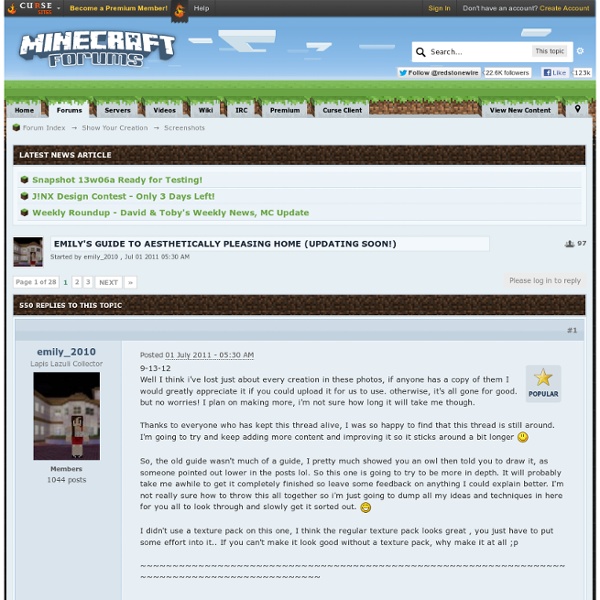Perfect spheres - blueprints inside
Introduction I found that stacking circles with alternating radii wasn't accurate enough for me, especially for large spheres. That's why I've written a script to generate mathematically perfect spheres. (Click to enlarge. This was done by using a (larger version of a) blueprint like this one: If you don't see how it's done right away, there's a description below. Features No redundant voxels. Blueprints How to use them Here's an example of one of the blueprints. Open the blueprint in some graphics program. The blueprints Here they are, ordered by diameter. If the connection times out, it is a temporary error. About the algorithm It's basically a really mindless straight forward procedure: Calculate sphere, convert to image. Generate a 3D array of size Diameter^3, fill with zeros. Larger spheres, more complex geometries There are some other players around who have written programs similar to mine.
Weekly Bridges: Arch Bridges
Whether it's to amaze your friends, or simply build a sustainable bridge across water, you need to know the basics of bridge-building. I'm not the "Expert", but I have built a variety of bridges in minecraft. My current project is a Brooklyn Bridge style suspension bridge. I plan to, hopefully every week, give a few tips about bridge building. Just to give an example of a small arch bridge I build today, This bridge connects the mainland to some newly generated land that we plan to use for agriculture and raising bacon On to the importants! Solid Arch Bridge This is the exact bridge that is used in my example (Redstone simulator ftw xD) and it's very useful for bridges that need to span a long ways and not be too big. You can make a 10 block+ bridge in height for deep valleys, but I don't suggest making huge arch bridges for spanning across oceans, due to them being awkwardly out of proportion. Open-Structure Arch Bridge I really suggest making these out of iron (Personally Gold
[Guide] Building Your Base in Minecraft
-Seed farm: One can easily make a seed farm by having a patch of grass in your base that's above your head. Bonemeal it from below, and then use a piston-controlled stream of water to bring the seeds down onto your head! -Wheat farm Bread is a good food source for everyday Minecrafting. It revives your hunger bar 2 and a half bars, and is stackable for easy carrying. Wheat is stackable too, so you can have a few stacks of wheat and a crafting table in your inventory, and be set on food for quite a while. Open the spoiler for an example of a wheat farm. Spoiler: -Melon farm Melons are a good food source in the game. -Pumpkin farm While Pumpkins aren't a food source, and aren't useful for too many things, they are good for making into Jack-O Lanterns as a cheap substitute for Glowstone, or put them on your head to avoid Endermen! -Mushroom farm Mushrooms! -Sugarcane farm Sugarcane is a lot more useful than it's made out to be. -Tree farm Ah, the tree farm. -Blaze farm Use Etho's design.
Schematics
[Tutorial] Building Tips and Strategies - POST YOUR TREE MODELS!
Many players start with the outer walls of a house, like we did in this tutorial. Interior is a difficult topic, because you can't paint a wall with a different color on the inner side, so you have the same wall material on the inside, and the same block for floors and ceilings. To solve this problem, just make separate inner and outer walls, separate floors and ceilings. A room inside a building does not have to fit the outer shape of the building. Rooms are just containers inside the building. You need a big building for this technique, because you need at least 1 additional block of space for separate ceilings and walls. Tip: The space between the inner and outer walls can be used for vertical redstone wires, if you want a light switch on a wall. IronwillNeo, on 20 December 2012 - 10:35 AM, said: Unflexible design: The wall is just 1 block wide, you can see the endstone and window frames inside. The same element, this time with separate walls.
Beautiful Medieval House Tutorial!
Ok guys, so many of you have requested that I make a tutorial for a house that I built, so I gave in, and here it is! Sorry if I skip around a bit, this is my first tutorial. Step 1: Place Spruce logs facing upwards in this pattern, which is 17 X 17, including the log in the middle, and the two logs at the bottom. Step 2: Stack 3 more logs on top of each of these, to make them 4 blocks high. Step 3: Connect these logs together at the top in this pattern, with the logs facing sideways. Step 4: Now stack 4 more on top of these, in this pattern, which will become our second floor. Step 5: Connect these at the top, just like in step 3. Step 6: Stack 5 more logs on top of these. Step 7: Once again, top it off! Step 8: Add 5 more logs on top of this, then top it off again. Now for the roof! Step 9: Right here, you will build a triangular shape on top of this, to support the roof. Step 10: Do this now on the top! Step 11: Now we start working on the roof. Step 12: Now we'll build the rest of the roof. Step 13:



